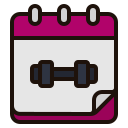Creative Ways to Incorporate Exercise into Everyday Life
Finding time for exercise can be a challenge in our busy lives, but physical activity doesn’t always require a gym membership or a dedicated workout session. By cleverly weaving movement into your daily routine, you can boost your fitness with minimal disruption. In this guide, discover inventive methods to stay active throughout the day, seamlessly transforming mundane moments into valuable opportunities for wellness. Embracing these small changes can lead to big benefits for both body and mind, all without sacrificing your schedule.
Walking the Extra Mile
Opting to walk instead of drive for short trips is a simple yet effective way to add movement into your day. Parking further away from your destination, getting off public transport a stop early, or simply planning a brisk walk into your route can add thousands of steps to your daily count. This not only improves cardiovascular health and stamina, but also offers a mental break, allowing you to clear your mind and enjoy your surroundings. Making these small changes requires minimal extra time, yet delivers measurable health rewards.
Cycling for Convenience and Fitness
If walking isn’t convenient, consider cycling as a speedy and invigorating option. Many cities now offer safe, designated bike lanes catering to commuters. Cycling to work or while running errands burns calories, tones muscles, and reduces your carbon footprint. You’ll likely find that the endorphin rush from cycling invigorates your mood as well, making it not just a mode of transport, but a revitalizing part of your daily schedule. Even a short fifteen-minute ride can make a significant difference over time.
Public Transit with a Twist
Even if you rely on public transit, there are creative ways to boost your activity level during your commute. Standing instead of sitting on the bus or train engages your core and balances muscles. Taking the stairs at stations rather than the elevator adds a quick cardio workout to your day. When possible, briskly walking between transfers or choosing a further entrance can contribute to reaching your daily movement goals, all while seamlessly fitting into your existing schedule.
Previous
Next
Workplace Workouts: Move More at the Office
When long meetings and tight deadlines fill your agenda, desk exercises can offer a much-needed movement break. Simple routines like seated leg lifts, calf raises, or subtle core contractions strengthen muscles and improve circulation. Setting an hourly reminder to stretch your arms and shoulders, or to perform a few chair squats, helps combat the negative effects of prolonged sitting. Over time, these mini sessions provide cumulative benefits, fostering flexibility and reducing discomfort, all within the confines of your workspace.
Active Home Life: Sneak in Fitness at Home

Turning Household Tasks into Workouts
Household chores like vacuuming, sweeping, gardening, or washing windows can double as moderate physical activity. Performing these duties with intentional vigor—using large, sweeping motions or adding lunges and squats—can elevate your heart rate and engage a variety of muscle groups. Turning on some music and setting a brisk pace converts cleaning into an opportunity for calorie burning and stress relief. These activities may seem routine, but when approached mindfully, they provide consistent, meaningful exercise that supports overall fitness.

Family Fitness Routines
Incorporating exercise into family time supports everyone’s health while strengthening bonds. Simple activities like dance parties, games of tag in the backyard, or group yoga sessions can make fitness fun and inclusive. By involving children and partners in active play, you model healthy habits while ensuring everyone benefits from regular movement. Over time, these shared experiences not only improve physical health, but also create lasting memories and encourage a lifelong love of activity within the home environment.

Exercise During Screen Time
It’s easy to become sedentary during television or gaming sessions, but these moments offer valuable opportunities for movement. Performing stretches, yoga poses, or bodyweight exercises like squats and pushups during commercial breaks keeps muscles engaged and energy levels up. For longer viewing, consider using a mini stepper or jogging in place. With a little planning, screen time can shift from passive relaxation to an active part of your fitness journey, ensuring that your favorite shows and hobbies support, rather than hinder, your well-being.
